Cezanne, Paul
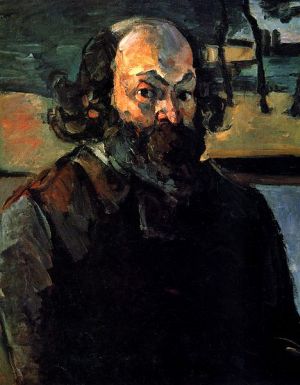 Paul Cézanne was born in 1839 at Aix in Provence France. His stern father was a successful hat dealer and exporter who co-founded a banking firm. Cezanne, while attending the College Bourbon, was friends with Émile François Zola (1840-1902). The friends shared a love of literature and developed a friendly rivalry in prose and poetic compositions.
Paul Cézanne was born in 1839 at Aix in Provence France. His stern father was a successful hat dealer and exporter who co-founded a banking firm. Cezanne, while attending the College Bourbon, was friends with Émile François Zola (1840-1902). The friends shared a love of literature and developed a friendly rivalry in prose and poetic compositions.
During a visit to Paris, Zola introduced Cezanne to Courbet and Manet. His artistic endeavors transitioned from writing to painting. His early works were influenced by Delacroix, Daumier, Courbet and Edouard Manet. When he informed his father that he wished to pursue painting rather than study law and join his father’s bank, Paul’s father replied “Think of the future. One dies with genius, but one eats with money.”
Due to his mother’s strong influence, his father begrudgingly offered the young artist a monthly allowance of 125 francs a month (about $25 American dollars). But, that amount was cut in half when his father discovered Paul had a child with his mistress Hortense Fiquet without benefit of marriage. Paul borrowed money from Zola to keep food on the table for his mistress and son. A year later his mother intervened and the allowance was restored. Cezanne legally married the mother of his child to placate everyone. Upon his father’s death several years later, Cezanne, who had always hated his father, deemed him a genius particularly in light of the large inheritance the artist received.
His marriage was an unhappy one. She preferred Switzerland and lemonade; he hated Switzerland and preferred France. He saw her infrequently and that was often only to use her as a model for his paintings as she was able to sit still and keep her mouth shut. Cezanne was fond of his son and admitted that “The boy is smarter than I am, I have no practical sense.” Paul Jr. would assume the responsibility of managing his father’s business and serve as his agent.
Cezanne was believed to not really have cared for people. He much preferred being alone with the natural landscapes and objects that he painted. He was quite particular in his painting. He would pick up paint with his brush and often take 15 minutes just deciding on the perfect place to dab it. Human models were a trial for Cezanne because most simply could not sit still as long as it would take him to paint them. Fruit and flowers would wither and rot long before he would finish painting them so Cezanne took to using artificial replicas as his models.
The artist seemed to have great difficulty transferring his visions to canvas and was known for his explosive temper both in his work and when with others. He was known to fly into great rages and viciously slash his own works to ribbons. Ambroise Vollard, a major art dealer of the time, related the story of how he came across one of Cezanne’s unfinished works hanging from a cherry tree. The artist had flung it there in frustration but later took it down and continued to work on it.
It seemed destined for Cezanne to join the movement when one of his early teachers, Camille Pissarro was one of its founders.
Cezanne, Pissarro, Manet, Degas, Renoir and Claude Monet believed paintings should reflect the painter’s interpretation of what they saw and not a perfect copy of the original. This Impressionist style was in conflict with what the French considered art in the 1860′s. Tradition called for painters to paint in a studio. These young upstarts painted the real world by being out in it.
Vollard gave Cezanne a one-man show in 1899. The only sale was made to a blind man who explained Cezanne’s thick use of pigments allowed him to “feel the painting.” Impressionism was growing in its appeal but Cezanne never enjoyed that trend. Even his life-long friend Zola turned on him when he published his novel L’Oeuvre which was obviously based upon Cezanne’s life. The primary difference being between the novel and the real artist was the fictional Cezanne ended his own life to escape his frustration over his art. Zola, who had been a staunch defender and standard bearer for the Impressionists, turned on them all by writing disparagingly of his former friends. The ultimate irony is that younger artists were starting to use Paul Cezanne’s technique as their model. He tended to define an object’s depth and mass through the use of color in a technique referred to as “modulation.” This new method would become the basis for “modern art.” Which in turn, meant in reality, that Cezanne is credited with leading the charge against Impressionism and is often classified as a “post-impressionist.”
Cezanne grew more remote from his friends and told the few visitors he had about how little respect he had for Pissarro and Zola. He continued to paint nature while continuing to withdraw from society. He swore he would die with a paintbrush in his hand and that nearly came to pass. While painting, Cezanne got caught in a violent storm, fell and was exposed to the weather for hours. He died a week later on the 22nd of October in 1906.

Paul Cezanne (1839-1906) painted this still life sometime around 1870. The clock itself adds a bit of mystery as it has no hands to tell us the time. The large conch shell with it’s reddish-orange gaping opening seems more the…
Read more

Portrait of Louis-Auguste Cezanne is a portrait that has the distinction of being the only painting Paul Cezanne (1839-1906) that was accepted by the jury of the official Paris Salon. Cezanne worked on this portrait while also working on Uncle…
Read more

An early Cezanne entitled Uncle Dominique as a Monk displays his palette knife work and portrays the artist’s uncle in a Dominican habit.
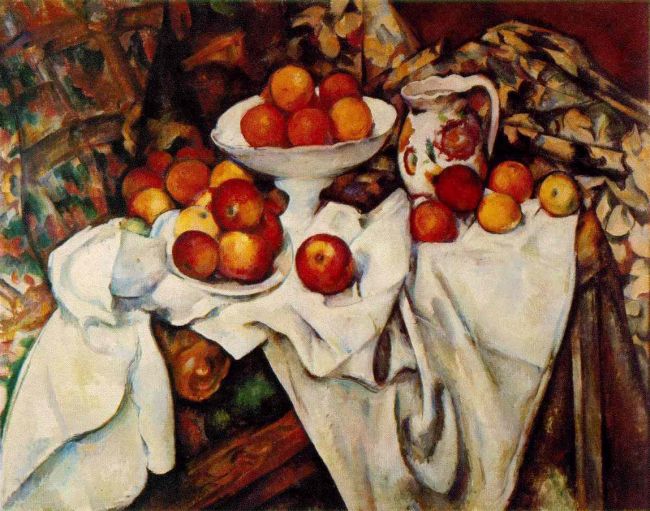
…by the famous artist Paul Cezanne Lively and colorful still life painting by Paul Cezanne (1839-1906) of a table full of apples and oranges. One of six in a series, some consider this painting one of the best still lifes…
Read more
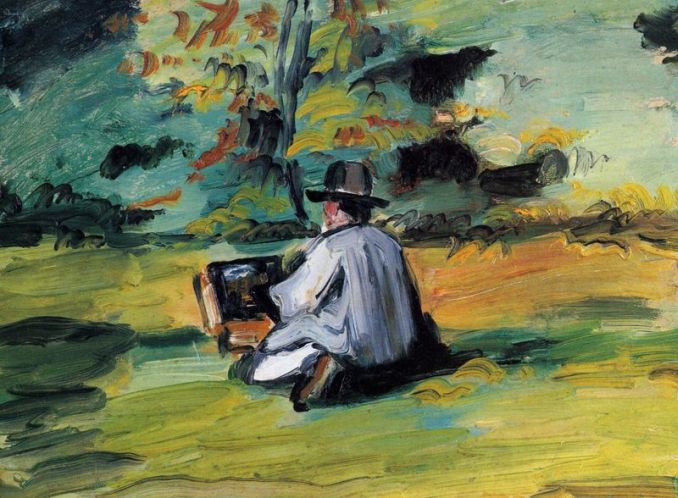
Bold splashes of color really frame an artist at work. Paul Cezanne (1839-1906) is known as both a French impressionist and one of the founders of modern art. He worked during a time when concept of painting out in the…
Read more
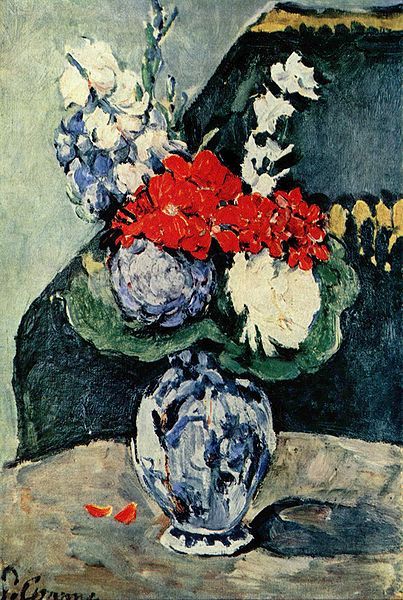
Lovely Delft vase full of red, blue and white flowers are the focal point of this still life painting finished by the famous artist Paul Cezanne (1839-1906) in 1874. A few red petals have fallen down onto the circular table…
Read more
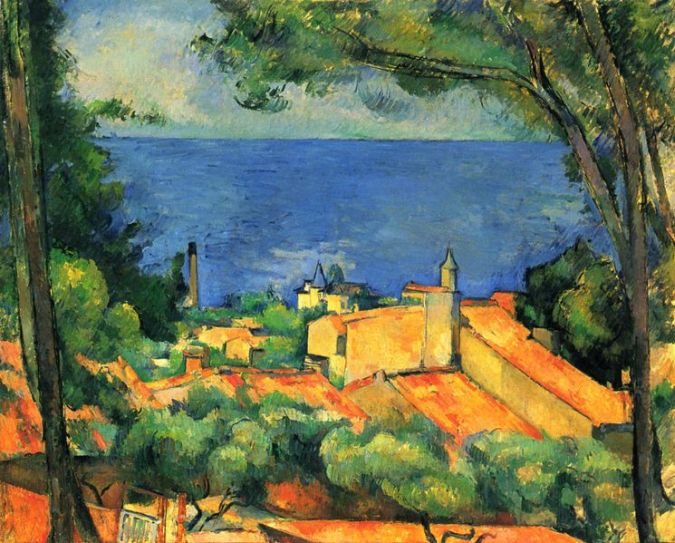
This oil on canvas is one of a number of landscape paintings completed by the famous artist Paul Cezanne (1839-1906) of a small French fishing village. L’Estaque is just west of Marseille. Many Impressionists and Post-Impressionists spent time here and…
Read more
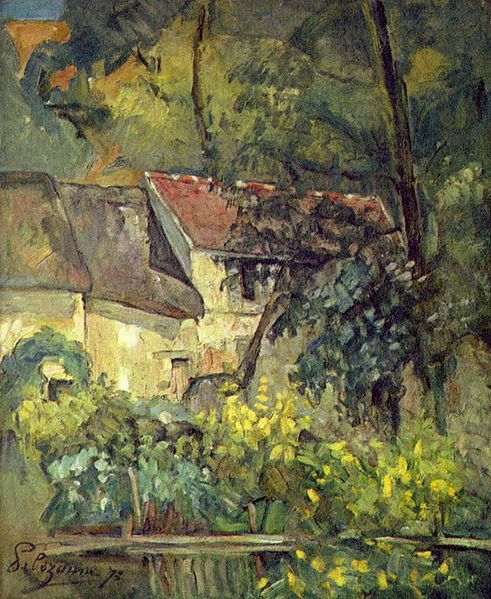
Painted in Auvers, France in 1873, by the famous artist Paul Cezanne (1839-1906), this landscape painting features a home in the village. In 1873, Cezanne and the artist Camille Pissarro(1830-1903) were living in Auvers and often painted together. Both painted…
Read more

 Paul Cézanne was born in 1839 at Aix in Provence France. His stern father was a successful hat dealer and exporter who co-founded a banking firm. Cezanne, while attending the College Bourbon, was friends with Émile François Zola (1840-1902). The friends shared a love of literature and developed a friendly rivalry in prose and poetic compositions.
Paul Cézanne was born in 1839 at Aix in Provence France. His stern father was a successful hat dealer and exporter who co-founded a banking firm. Cezanne, while attending the College Bourbon, was friends with Émile François Zola (1840-1902). The friends shared a love of literature and developed a friendly rivalry in prose and poetic compositions.





